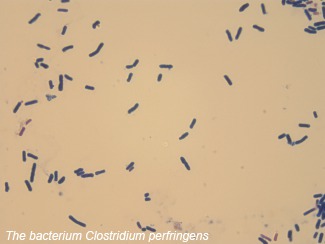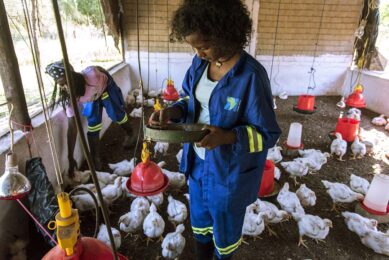Enteric diseases with special attention to Clostridium perfringens

Several enteric disorders affect poultry and cause illness, mortality and economic losses. The ban on antibiotic growth promoters increased the problem by allowing intestinal bacteria, influenced by predisposing factors, to destroy the internal lining of the gut. How do you recognise the problem and what can be done about it?
By Prof. Dr. Hafez Mohamed Hafez, Institute of Poultry Diseases, Faculty of Veterinary Medicine, Free University Berlin, Germany
Enteric disorders are one of the most important groups of diseases that affect poultry, continuing to cause high economic losses worldwide due to increased mortality rates, decreased weight gain, increased medication costs, and increased feed conversion rates. Several pathogens (viruses, bacteria and parasites) are incriminated as possible causes of enteric disorders either alone (mono-causal), in synergy with different other microorganisms (multi-causal), or with non-infectious causes such as feed and/or management-related factors (Table 1). Under field conditions, however, it is difficult to determine whether the true cause of enteric disorders in poultry is of infectious or non-infectious origin.
The “Precautionary Principle”
It has been known for many years that supplementing poultry feed with antibiotic growth promoters (AGPs) improves the performance of livestock. The effect of AGPs on gut flora results in improved digestion, better absorption of nutrients, and a more stable balance in the microbial population. As a result, intestinal disorders are reduced. However, AGPs can also increase the prevalence of drug-resistant bacteria.
Based on the “Precautionary Principle”, the EU placed a complete ban on the use growth-promoting antibiotics in the feed of food producing animals in January 2006. The impact of the ban has been seen on the performance (body weight and feed conversion rate) as well as on rearing husbandry (wet litter and ammonia
level), animal welfare problem (foot pad dermatitis) and general health issues on the birds (enteric disorders due to dysbacteriosis and clostridial infections).
Five biotypes
Enteric disorders are frequently associated with an overgrowth of Clostridium perfringens. Infections with this bacterium in poultry can cause several clinical manifestations, and lesions include Necrotic Enteritis (NE), Necrotic Dermatitis, cholangiohepatitis, as well as gizzard erosion. However, subclinical infection can take place too. In addition, C. perfringens type A has been shown to cause food poisoning in humans.
C. perfringens is a Gram-positive, non-motile, spore-forming anaerobic bacterium, which is widespread in soil, feed, litter, and the intestinal tract of diseased and healthy birds. The bacterial spores are very resistant to heat, desiccation, acids and many chemical disinfectants.
C. perfringens is divided into five biotypes (A, B, C, D, and E) based on the synthesis of four major lethal toxins, being alpha, beta, epsilon, and iota. Along with these four major toxins, enterotoxin (CPE) and beta2 (CPB2) toxins produced by C. perfringens are considered as important toxins for enteric diseases. However, it is not clear whether CPE and CPB2 are involved in C. perfringens-associated avian enteric diseases. The infections in poultry are mostly caused by C. perfringens type A, and to a lesser extent by type C. Because C. perfringens type A is highly prevalent in the intestines of healthy animals, controversy exists about its real pathogenic role. Recently, a novel toxin (NetB) in a C. perfringens type A strains isolated from chickens in Australian suffering from NE was identified. According to the authors this novel toxin is the first definitive virulence factor to be identified in avian C. perfringens strains capable of causing NE.
Importance of predisposing factors
NE is an acute disease caused by C. perfringens when proliferates to high numbers in the small intestine, and produces toxins responsible for damaging the intestinal lining. The disease has been observed in several domestic and wild birds worldwide. Besides clinically manifested disease, subclinical infections may take place and are mostly accompanied with reduction of performance due to damage of the intestinal cell lining. The most important source of infection in poultry appears to be contaminated litter, water and the environment and feed. In general, the presence of C. perfringens in the intestinal tract or inoculation of the animals with high doses of C. perfringens, however, does generally not lead to the development of NE. One or several predisposing factors may be required to elicit the clinical signs and lesions. It appears that some dysfunctions of the alimentary tract and alternation of intestinal flora are necessary predisposing cause of infection. Intestinal stasis, intestinal distension, coccidiosis, salmonellosis, may predispose the birds to infection. Further factors are the consumption of diets high in energy, protein and fish meal, as well as wheat-based diet.
Clinical signs
The clinical signs appear suddenly; apparently healthy birds may become acutely depressed and die within hours. Mortality ranges between 2 and 10%. Affected birds show ruffled feathers, marked depression, inappetence, tendency to huddle, watery droppings and diarrhoea.
On autopsy, dehydration is the most common finding. Breast muscles are dark red and gizzards are full. Severe inflammation in the duodenum and jejunum is the most predominant finding, but in some instances the entire length of the intestinal tract is involved. The intestine is distended and contains dark offensive fluid. The mucosa is covered with green or brown diphteroid membrane, which can be easily separated from the lining. Varying degrees of sloughing of the intestinal mucosa could also be observed. As the condition progresses, areas of necrosis can be recognised from outside the intestine.
A presumptive diagnosis may be made from the case history, clinical signs, lesions, and staining fresh smears of upper part of the intestinal tract with Gram stain showing an abundant number of clostridia organisms. This should be confirmed by the isolation of the causative agent and determine the toxins using PCR as well as a real-time PCR for quantitative detection of C. perfringens in the gastrointestinal tract.
Treatment options
Treatment with antibiotics such as penicillin, amoxicillin, ampicillin, erythromycin, dihydrostreptomycin and tetracyclin provide a satisfactory clinical response. Penicillins are known to be particularly active against C. perfringens. Resistance to penicillin is very rare and β-lactamase has not been demonstrated. Three days is the minimum duration of treatment, but longer applications may be required. The administration of dietary Tylan® or seven consecutive days following confirmation of an NE field outbreak reduced the NE mortality and lesion scores in broilers. Furthermore, several experimental vaccines were tested and showed promising results.
Further approaches are generally used to combat the clostridial infection, such as the use of highly digestible feed ingredients, improvement of climate, control of litter quality, and a reduction in the stocking density, which leads to enhance the performance and improves the health status of the birds. In addition, the use of alternative products to modulate the intestinal flora such as competitive exclusion, prebiotics, probiotics, enzymes and acids can impact the incidence and severity of NE. The practical relevance of these approaches may vary between the different areas and farms.
In conclusion, the implementation of several approaches, such as improvement of management, feed formulation and limiting exposure to infectious agents through biosecurity, supportive therapy, cleaning and disinfection are essential. In addition, early recognition in managing the enteric disorders is very important.
Join 31,000+ subscribers
Subscribe to our newsletter to stay updated about all the need-to-know content in the poultry sector, three times a week. Beheer
Beheer








 WP Admin
WP Admin  Bewerk bericht
Bewerk bericht